|
|
|
A beautiful photo of the WSM transmitter building and Blaw-Knox tower by |
For questions, information about WSM and
programming, please visit the WSMONLINE.COM official website.
(Jim Hawkins' Radio & Broadcast Technology Page)
|
|
|
A beautiful photo of the WSM transmitter building and Blaw-Knox tower by |
For questions, information about WSM and
programming, please visit the WSMONLINE.COM official website.
by
Watt Hairston, CE of WSM
Blaw-Knox dual cantilevered (center guyed towers). A.k.a. "diamond antenna".
WSM-AM tower I-65 and Concord Road, Brentwood, TN.
Any tower structure exhibits many dynamics that result from gravity, wind and temperature cycles. These forces
are constantly at work and result in movements vertically and horizontally of the structure. These movements (even
slight) result in tremendous tensions where the structure attaches to a very rigid earth through its foundations.
Most specifically the horizontal twisting that results, becomes a formidable "moment". To compensate
for this, either the strength of the structures lower components (where the moving tower meets the non-moving foundation)
must be massive enough to compensate for this "moment" or attached to the foundation through a hinge
mechanism in the form of a pivot. Thus the tapered base we see on most towers of significant length.
With all this in mind we can reason that for a tower of the height of 808 feet the dynamics (movements) are integral
to the mass of the structure. The higher the tower, the size and strength of the lower supports must grow at an
un-proportionate rate. If this tower were not tapered, the lower supports (where this twisting moment couples to
the foundation) would have to be so large as to make the project extremely costly to accomplish. In the case of
AM towers that are electrically insulated from the ground, the problem is magnified because the tower has to rest
on porcelain insulators that would be located at the transition to the foundation. The point of maximum force.
In a pivot attachment, the moment is not critical because the tower can rotate on its base. This is why tower manufactures
use this mechanism to this date. The WSM tower lower half is made up of larger steel members than the top section.
Where the bottom taper is linear, the top is not. There is a transition at about the 680-foot level. Eight guy
cables are attached at the joining section between the tapers. The entire weight of the tower and the pull of the
guy cables rest on a two-section series pivotal Lapp insulator. This tower represents the construction methods
and technology at the time. The laws of physics remain unchanged.
The WSM tower was erected in 1932 and began operation from it late that year and is still in-use today. The tower
was designed and manufactured by The Blaw-Knox Steel Company of Pittsburgh Pa. The original mechanical drawings
are very detail. The erection crew was from South Carolina. Originally, the WSM tower was 878 feet tall. This included
758 feet of square structural lattice then 120 feet of tapered mast. By 1939, it was determined the tower was electrically
longer due to velocity effect. This contributed to a very high angle of radiation that resulted in a groundwave/skywave
cancellation (fade) over Chattanooga some 120 miles distance. This condition was alleviated by this adjustment
in height to 808 feet. As a side note, part of the mast was erected as the flagpole for the adjacent Lipscomb School.
It was in use there until 1996 when the original school building was replaced. 50 feet of the pole still exist
on the top of the tower. It was used to support a turn style antenna for the FM station that WSM operated at this
location from 1939 until 1952. The original antenna was in the 45 MHz band. After World War II, the FM allocation
moved up to 100.1 MHz. The antenna was replaced with another turn style antenna. That antenna is still up there.
WSM relinquished the FM station license in 1952 as television was on the scene and FM broadcasting was no where
near profitability.
Blaw-Knox went out of the tower business in 1958. There are several of these types of towers still in use besides
the WSM tower. The same crew that installed the WSM tower installed the WLW tower near Mason Ohio. In fact, the crew went directly to Ohio when they finished WSM.
There are three shorter versions of these towers at WBT in Charlotte, NC. Blaw-Knox built taller towers as well.
The WSMV-TV tower is 1369 feet tall and has a 12-foot width face. This tower supports the antennas of WSMV-TV,
WSM-FM and WZTV-TV. It is the classic pivotal base sectional guyed tower.
Prior to using the Blaw-Knox tower, WSM used a "cage" type antenna that was supported by two self-supporting
towers. A wire was strung between the towers and a vertical feed wire fed the center from a tuning house directly
centered between the towers. This was also referred to as a "flat top" antenna. Dr. George Brown et.
al, of RCA fame, impressed the FRC with his vertical, series fed antenna that used 120 quarter wavelength radials
as 360 degree counter-poise. There have been no improvements on this design to date. Dr. George Brown (like Blaw-Knox)
is deceased.
There has been some suggestion that the Blaw-Knox tower was designed to be "fat" in the middle to accommodate
a current loop (I max) in a 1/2 to 5/8 wave length tower. This was purely consequential and was not a consideration
in the design of the tower.
W. Watt Hairston (N4UHE)
Chief Engineer
WSM
Nashville, TN.
Kara Hairston is a serious amateur photographer with skills in
the darkroom as well as behind the camera.
| Wide angle view of WSM 50KW transmitter. |
Final amplifier compartment original WSM transmitter circa 1932. Tubes are water cooled UV-862s. |
Overhead view of WSM transmitter 1932 with regular lense. |
| Watt Hairston on the old transmitter: "It used 849's in the low stages. The driver was an 849, which was plate modulated. That drove two 892R's in parallel, which drove the two UV862's that were configured as a doherty. Bias was developed in motor generator sets. Filamentss were AC. The transmitter used over-all rf feedback." |
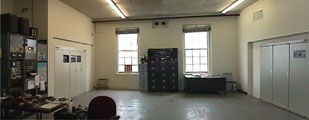 |
|
WSM transmitters, today. Same view as above |
Before the DX-50 Was Betty, a blue GE 50KW transmitter. It has been converted for use on the shortwave bands.
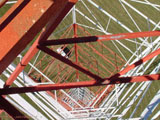 |
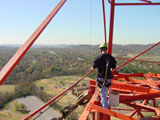 |
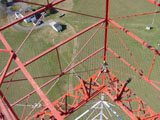 |
|
John Hettish photos from up on the WSM Blaw-Knox |
||
| These photographs document WSM's first attempt in FM broadcasting and only "short-wave" known then as "Ultra High Frequency Station". This activity began in 1938. The "short-wave" was shut down just before WW-II. The FM operated at 44.7 Mhz until 1946 when it moved to 103.3 Mhz. That operated until 1952 and was shut down at that time. WSM began television broadcasting in 1950 and that overshadowed the FM. It was not until 1968 that WSM again began broadcasting on FM at 95.5 Mhz. From the TV transmitter in West Nashville. The Short-wave as well as the FM and TV transmitters were designed and built by the WSM engineering department. |
|
1939 FM transmitter That operated at 44.7 Mhz. TPO was 10 Kw, driver tubes in left compartment were 833A's (yes, that's correct), PA tubes in the right compartment were GL-889's and were water-cooled. |
|
| Same transmitter from rear shows GL-889's mounted in tuning stubs. The white coils in the bottom are Lapp porcelain water coils that isolated the plate-voltage from the cooling water. Filament transformers can be seen mounted from the ceiling. The transmitter was designed and constructed by the WSM engineering staff. | |
| This shows the high-voltage plate supply located on the lower floor of the WSM-AM building. It was purchased as a unit from General Electric. Plate voltage was 7800 volts for the GL-889's. Behind the cage and above the transformers can be seen seven mercury vapor rectifier tubes. Six were in use while the seventh was a spare that was in "hot" stand-by and could be configured into the system using jumpers. |
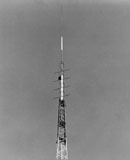 |
This is the "turn-style" antenna during installation on the mast of the WSM-AM tower. Note workmen on the tower and mast. The effective radiated power was 60,000 watts. This was in early 1939. |
| Note: I was able to reach long-time WSM engineer Charles Burch today. He has been retired from WSM for 20 years. In his 80's, he was slow to remember details but as we chatted, he began to remember about the FM as well as the AM transmitter. He related that the transmitter was not stable at all. Even worse when it was converted to 103.3 Mhz. He said "It was nice to look at and the craftsmanship was excellent, it just didn't work well at all!" It was good to talk to Charles after many years. We talked for a long time and it seemed as we went along, his memory improved as he challenged those brain cells. It was a positive for the day and made my week. |
| WSM's brief venture into what is now known as "Short-wave" broadcasting featured in this advertisement in "The Nashville Banner" afternoon news paper. (Now defunct) Announcing the opening of "W4XA". The station was referred to as "Ultra High Frequency station". According to the ad, it operated at night. It was shut down at the beginning of World War Two (as I understand it) at the direction of the War Department. |
|
Harris HTD-50CD |
| Accessed | times since March 8, 2001. |
BACK TO "JIM HAWKINS RADIO & BROADCAST TECHNOLOGY PAGE
All images are Copyrighted and are provided for your personal enjoyment. Use of these images for commercial purposes including their distribution on CD-ROM or any other media without permission of the owner is prohibited. Jim Hawkins